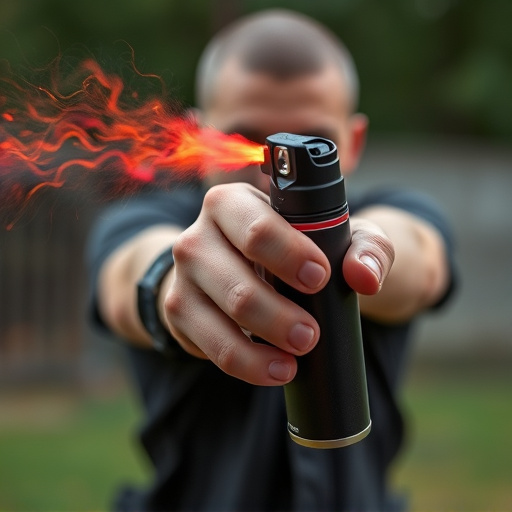Bear spray, using capsaicin to deter aggressive bears, should be aimed at the face of charging predators (20-30 feet range) during an attack. In case of exposure, immediately seek medical attention for eye washes and follow decontamination guidelines. After use, thoroughly rinse affected areas with cool water for 15 minutes, avoid soap, and dry gently. Contaminated clothing should be removed and washed in hot water (at least 105°F) with detergent. For skin irritation, use calamine lotion; for eye exposure, seek urgent medical care to prevent severe damage. Safety is paramount; bear spray is a last resort, and proper usage/post-exposure care are crucial, including noise-making and carrying alternative defense mechanisms.
Bear spray is a powerful defense mechanism against aggressive animal encounters, especially in wild environments. This article delves into the effectiveness of bear spray, offering insights on its composition, usage, and post-exposure care. We explore the ‘when’ and ‘how’ to apply it during attacks, emphasizing safety measures. Learn about alternative defenses and crucial steps to treat pepper spray exposure, ensuring you’re prepared for unexpected situations in nature. Discover the importance of understanding these tools for outdoor enthusiasts.
- Understanding Bear Spray: Composition and Effectiveness
- When and How to Apply Pepper Spray During an Attack
- Post-Exposure Care: Treating Pepper Spray on the Body
- Safety Measures and Alternative Defense Mechanisms
Understanding Bear Spray: Composition and Effectiveness
Bear spray, also known as pepper spray designed for wildlife encounters, is a specialized defense mechanism used to deter aggressive bears. Unlike traditional pepper spray used for self-defense against humans, bear spray is formulated to be highly effective against large predators like grizzly and black bears. It’s composed of capsaicin, the same compound that gives chili peppers their heat, along with various preservatives and aerosolizing agents to ensure a wide reach.
When sprayed directly into an animal’s face, capsaicin irritates the bear’s eyes, nose, and throat, temporarily blinding it and causing intense discomfort. This provides the user with crucial time to escape or defend themselves. Understanding how to properly use and treat pepper spray exposure is vital. If exposed, immediately seek medical attention for eye washes, and ensure you follow local guidelines for decontamination areas.
When and How to Apply Pepper Spray During an Attack
During an animal attack, applying bear spray can be a life-saving measure, but timing and technique are crucial. The ideal moment to use pepper spray is when the animal is within 20 to 30 feet (6 to 9 meters) and charging towards you. At this range, you have enough time to activate the spray and create a barrier between you and the attacker. Hold the can upright, point it at the approaching creature’s face, and pull the trigger quickly but firmly. The goal is to fill the immediate air with the spray, aiming for direct eye contact if possible. This approach disrupts the animal’s sense of smell and vision, temporarily deterring it from continuing the attack.
After applying the spray, back away slowly while keeping an eye on the animal’s movements. If the initial burst doesn’t stop the assault, a second application might be necessary. In cases of prolonged exposure to pepper spray, whether during or after an attack, How to Treat Pepper Spray Exposure is essential. This includes quickly moving to a safe area with good ventilation, removing contaminated clothing, and flushing eyes and skin with water for at least 15 minutes. Seeking medical attention should also be considered, especially if breathing becomes difficult or symptoms persist beyond the initial irritation.
Post-Exposure Care: Treating Pepper Spray on the Body
After a bear spray encounter, proper post-exposure care is crucial to managing any irritations or potential reactions. The first step in how to treat pepper spray exposure involves quickly rinsing the affected areas with plenty of cool water for at least 15 minutes. This helps to dilute and flush out the capsaicin oil responsible for the burning sensation. Avoid using soap, as it can further irritate the skin.
Once rinsed, gently dry the area with a clean cloth or towel. If clothing is contaminated, remove them carefully and wash separately in hot water (at least 105°F/40°C) with a strong detergent to ensure all pepper spray residue is removed. Calamine lotion or an anti-itch cream can provide relief from temporary skin irritation. In case of eye exposure, seek immediate medical attention as pepper spray can cause severe eye damage if not properly treated.
Safety Measures and Alternative Defense Mechanisms
When it comes to bear spray defense, safety measures are paramount. It’s crucial to understand that while bear spray is an effective deterrent, it should be used as a last resort. Always maintain awareness and distance from wild animals, make noise to signal your presence, and carry alternative defense mechanisms like bells or whistles. Bear spray is designed to incapacitate temporarily, but proper usage and knowledge of how to treat pepper spray exposure are essential. In the event of accidental exposure, quickly move to a safe location, wash affected areas with soap and water, and seek medical attention if symptoms persist or severe reactions occur.
Bear spray can be a valuable tool for defending against animal attacks, but understanding its composition, effectiveness, and proper application is crucial. After an encounter, proper post-exposure care, including treating pepper spray on the body, is essential. Additionally, knowing safety measures and alternative defense mechanisms can further enhance your protection in bear country. Following these guidelines, such as seeking medical attention for severe reactions and properly storing bear spray, ensures you’re prepared should you face such a situation. Remember, prevention is key, but being equipped with knowledge and the right tools can make all the difference.
